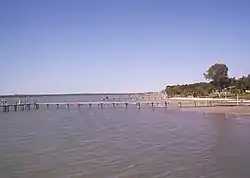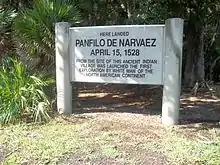Jungle Prada Site
The Jungle Prada Site (also known as Jungle Mound or Anderson-Narváez Site) is an archaeological site featuring Indigenous Tocobaga mounds and the location of the historical Narváez expedition landing. The Jungle Prada site spans public and private property, including the Jungle Prada de Narvaez city park, in St. Petersburg of Pinellas County, western coastal Florida, in the Southern United States.
Jungle Prada Site | |
 Looking north from the fishing pier at Jungle Prada de Narvaez Park | |
  | |
| Location | St. Petersburg, Florida |
|---|---|
| Coordinates | 27°47′19″N 82°45′08″W |
| NRHP reference No. | 03000007[1] |
| Added to NRHP | February 4, 2003 |
The Jungle Prada Site was added, on February 4, 2003, to the National Register of Historic Places.
History

The Tocobaga tribe inhabited the Jungle Prada site for approximately 600 years, from 1000-1600 CE.[2] Their village complex in the area once contained a series of mounds stretching up and down Boca Ciega Bay for more than 3 miles; however most of the mounds were dismantled and used as fill for 20th century urban development.[3] The Jungle Prada site mounds that remain include a 12 foot-tall plaza mound (likely used for ceremonial purposes) and a 23 foot-tall, 900 foot-long, 300 foot-wide midden mound, that stretches from the Jungle Prada de Narvaez public city park onto private property. The portion of the mounds that are on private property are considered "archeologically pristine."[4]
The Jungle Prada Site is believed to be at or near the 1528 landing site of the Spanish explorer Pánfilo de Narváez's Florida expedition to explore and expand colonial New Spain into North America.[5] Of the 450 members of the Narvaez expedition that landed at Jungle Prada, 300 departed on a disastrous overland expedition that boasted only four survivors, including Álvar Núñez Cabeza de Vaca who wrote an account of the journey. These men would walk to the Pacific Ocean over the next eight years, becoming the first Europeans and first person of African descent -- Estevanico to cross the North American continent.
The Diocese of St. Petersburg placed a marker at the Jungle Prada site, acknowledging it as the location of the first Catholic Mass in Florida. [6] In September 2012 a few miles north in Largo, St. Jerome Catholic Church unveiled three murals depicting the Narváez landing, the first Mass celebrated in Florida, and early interaction between the Spanish and the Tocobaga.
Location
The Jungle Prada site spans both public and private land. Portions of the Tocobaga mounds, as well as picnic tables, a fishing pier, and boat launch are located within the city park, and are maintained by the City of St. Petersburg. The better-preserved mounds, along with a small archeological museum, are located on private property and are accessible by guided tour. The Jungle Prada site is located on the eastern shore of Boca Ciega Bay, at Park Street North and Elbow Lane (17th Avenue) in St. Petersburg, Florida.
See also
References
- "National Register Information System". National Register of Historic Places. National Park Service. July 9, 2010.
- Simpson, Terrance. The Narvaez/Anderson Site (8Pi54): A Safety Harbor Culture Shell Mound and Midden – AD 1000-1600. Gulf Coast Archeological Society, 1998.
- Michaels, Will. The Making of St. Petersburg. Charleston: The History Press, 2012.
- Austin, Robert. “Jungle Prada Site – Registration Form for National Register of Historic Places.” Tallahassee: Bureau of Historic Preservation, 2002.
- MacDougald, James (2018). The Pánfilo de Narváez Expedition of 1528: Highlights of the Expedition and Determination of the Landing Place. St. Petersburg: Marsden House. ISBN 978-1-4834-8671-0.
- https://www.hmdb.org/m.asp?m=120361
External links
| Wikimedia Commons has media related to Jungle Prada Site. |
- National Register of Historic Places: Pinellas County place listings
- Florida's Office of Cultural and Historical Programs: Pinellas County listings
- Pinellas County Planning Department as staff for the Pinellas County Planning Council. (PCPD) Pinellas County Historical Background.
- Straub, W. L. History of Pinellas County. (Straub) The Record Company. St. Augustine, Florida. 1929.
- stpete.org: St. Petersburg Parks

